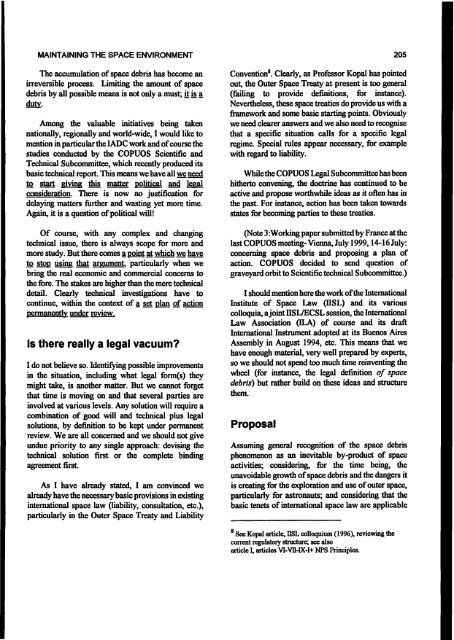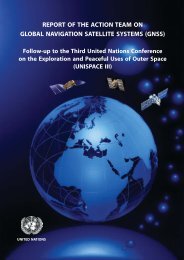Proceedings of the Workshop - United Nations Office for Outer ...
Proceedings of the Workshop - United Nations Office for Outer ...
Proceedings of the Workshop - United Nations Office for Outer ...
- No tags were found...
You also want an ePaper? Increase the reach of your titles
YUMPU automatically turns print PDFs into web optimized ePapers that Google loves.
MAINTAINING THE SPACE ENVIRONMENT 205The accumulation <strong>of</strong> space debris has become anirreversible process. Limiting <strong>the</strong> amount <strong>of</strong> spacedebris by all possible means is not only a must; it is aduty.Among <strong>the</strong> valuable initiatives being takennationally, regionally and world-wide, I would like tomention in particular <strong>the</strong> IADC work and <strong>of</strong> course <strong>the</strong>studies conducted by <strong>the</strong> COPUOS Scientific andTechnical Subcommittee, which recently produced itsbasic technical report. This means we have all we needto start giving this matter political and legalconsideration. There is now no justification <strong>for</strong>delaying matters fur<strong>the</strong>r and wasting yet more time.Again, it is a question <strong>of</strong> political will!Of course, with any complex and changingtechnical issue, <strong>the</strong>re is always scope <strong>for</strong> more andmore study. But <strong>the</strong>re comes a point at which we haveto stop using that argument particularly when webring <strong>the</strong> real economic and commercial concerns to<strong>the</strong> <strong>for</strong>e. The stakes are higher than <strong>the</strong> mere technicaldetail. Clearly technical investigations have tocontinue, within <strong>the</strong> context <strong>of</strong> a set plan <strong>of</strong> actionpermanently under review.Is <strong>the</strong>re really a legal vacuum?I do not believe so. Identifying possible improvementsin <strong>the</strong> situation, including what legal <strong>for</strong>m(s) <strong>the</strong>ymight take, is ano<strong>the</strong>r matter. But we cannot <strong>for</strong>getthat time is moving on and that several parties areinvolved at various levels. Any solution will require acombination o f good will and technical plus legalsolutions, by definition to be kept under permanentreview. We are all concerned and we should not giveundue priority to any single approach: devising <strong>the</strong>technical solution first or <strong>the</strong> complete bindingagreement first.As I have already stated, I am convinced wealready have <strong>the</strong> necessary basic provisions in existinginternational space law (liability, consultation, etc.),particularly in <strong>the</strong> <strong>Outer</strong> Space Treaty and LiabilityConvention8. Clearly, as Pr<strong>of</strong>essor Kopal has pointedout, <strong>the</strong> <strong>Outer</strong> Space Treaty at present is too general(failing to provide definitions, <strong>for</strong> instance).Never<strong>the</strong>less, <strong>the</strong>se space treaties do provide us with aframework and some basic starting points. Obviouslywe need clearer answers and we also need to recognisethat a specific situation calls <strong>for</strong> a specific legalregime. Special rules appear necessary, <strong>for</strong> examplewith regard to liability.While <strong>the</strong> COPUOS Legal Subcommittee has beenhi<strong>the</strong>rto convening, <strong>the</strong> doctrine has continued to beactive and propose worthwhile ideas as it <strong>of</strong>ten has in<strong>the</strong> past. For instance, action has been taken towardsstates <strong>for</strong> becoming parties to <strong>the</strong>se treaties.(Note 3: Working paper submitted by France at <strong>the</strong>last COPUOS meeting-Vienna, July 1999,14-16 July:concerning space debris and proposing a plan <strong>of</strong>action. COPUOS decided to send question <strong>of</strong>graveyard orbit to Scientific technical Subcommittee.)I should mention here <strong>the</strong> work <strong>of</strong> <strong>the</strong> InternationalInstitute o f Space Law (IISL) and its variouscolloquia, a joint IISL/ECSL session, <strong>the</strong> InternationalLaw Association (ILA) o f course and its draftInternational Instrument adopted at its Buenos AiresAssembly in August 1994, etc. This means that wehave enough material, very well prepared by experts,so we should not spend too much time reinventing <strong>the</strong>wheel (<strong>for</strong> instance, <strong>the</strong> legal definition o f spacedebris) but ra<strong>the</strong>r build on <strong>the</strong>se ideas and structure<strong>the</strong>m.ProposalAssuming general recognition o f <strong>the</strong> space debrisphenomenon as an inevitable by-product <strong>of</strong> spaceactivities; considering, <strong>for</strong> <strong>the</strong> time being, <strong>the</strong>unavoidable growth <strong>of</strong> space debris and <strong>the</strong> dangers itis creating <strong>for</strong> <strong>the</strong> exploration and use o f outer space,particularly <strong>for</strong> astronauts; and considering that <strong>the</strong>basic tenets <strong>of</strong> international space law are applicable8 See Kopal article, IISL colloquium (1996), reviewing <strong>the</strong>current regulatory structure; see alsoarticle I, articles VI-VII-IX-I+ NPS Principles.
















